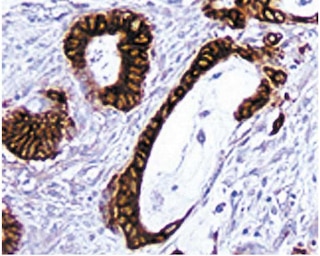Old Browser
This page has been recently translated and is available in French now.
Looks like you're visiting us from {countryName}.
Would you like to stay on the current country site or be switched to your country?






Formalin-fixed, paraffin-embedded tissue section of human prostate stained for androgen receptor using G122-25, (Cat. No. 554224), and detected with a DAB chromogen and methyl green.

Acetone-fixed, frozen tissue section of rat prostate stained for androgen receptor using G122-25, (Cat. No. 554224), and detected with an AKP system with a fluorescent chromophore.


BD Pharmingen™ Purified Mouse Anti-Human Androgen Receptor

BD Pharmingen™ Purified Mouse Anti-Human Androgen Receptor

Regulatory Status Legend
Any use of products other than the permitted use without the express written authorization of Becton, Dickinson and Company is strictly prohibited.
Preparation And Storage
Recommended Assay Procedures
Applications include flow cytometry (titrate between 0.06 and 1 µg/one million cells), immunohistochemical staining of acetone-fixed, frozen sections, and of formalin-fixed, paraffin-embedded tissue sections (5-10 µg/ml) and immunoprecipitation (1-2 µg/one million cells). Clone G122-434 (Cat. No. 554225) is suggested for western blot analysis. LNCaP prostate carcinoma cells (ATCC CRL 1740) are suggested as positive controls.
Product Notices
- Since applications vary, each investigator should titrate the reagent to obtain optimal results.
- Please refer to www.bdbiosciences.com/us/s/resources for technical protocols.
- Caution: Sodium azide yields highly toxic hydrazoic acid under acidic conditions. Dilute azide compounds in running water before discarding to avoid accumulation of potentially explosive deposits in plumbing.
- Please refer to http://regdocs.bd.com to access safety data sheets (SDS).
- Species cross-reactivity detected in product development may not have been confirmed on every format and/or application.
- Sodium azide is a reversible inhibitor of oxidative metabolism; therefore, antibody preparations containing this preservative agent must not be used in cell cultures nor injected into animals. Sodium azide may be removed by washing stained cells or plate-bound antibody or dialyzing soluble antibody in sodium azide-free buffer. Since endotoxin may also affect the results of functional studies, we recommend the NA/LE (No Azide/Low Endotoxin) antibody format, if available, for in vitro and in vivo use.
Companion Products



The androgen receptor (AR) mediating androgen effects is a member of the steroid and thyroid hormone receptor gene superfamily encoding ligand-dependent nuclear transcription factors. They can be divided into three main domains, an N-terminal domain which modulates transcription efficiency, a central DNA domain which binds to a target gene hormone response element, and a C-terminal hormone binding domain. Androgens are necessary for normal male development and function. They exert their effects on target tissue through binding to the AR, followed by association of the AR complex with specific binding sites on DNA. This AR complex may induce or repress gene transcription. Mutations in the AR gene are associated with androgen insensitivity syndrome, a disorder that causes XY genotypic males to develop as phenotypic females because of their inability to respond to androgens. AR mutations have also been identified in human prostate cancer specimens and the LNCaP human prostate cancer cell line. Monoclonal and polyclonal antibodies to the AR have identified AR-positive cells in a variety of tissues including male and female sexual organs, kidney, liver, adrenal cortex, pituitary gland, skeletal, cardiac, and smooth muscle cells. The androgen receptor migrates at a molecular weight of ~100 kD in SDS-PAGE. G122–25 recognizes an epitope localized within the DNA-binding domain (between amino acids 486 and 651) of the human androgen receptor. Additionally, G122–25 has been shown to recognize androgen receptors in frozen rat prostate tissue sections. G122–25 does not cross-react with estrogen or progesterone receptors. Purified recombinant human androgen receptor protein was used as immunogen.
Development References (5)
-
Chang C, Wang C, DeLuca HF, Ross TK, Shih CC. Characterization of human androgen receptor overexpressed in the baculovirus system. Proc Natl Acad Sci U S A. 1992; 89(13):5946-5950. (Immunogen). View Reference
-
Fuller PJ. The steroid receptor superfamily: mechanisms of diversity. FASEB J. 1991; 5(15):3092-3099. (Biology). View Reference
-
Newmark JR, Hardy DO, Tonb DC, et al. Androgen receptor gene mutations in human prostate cancer. Proc Natl Acad Sci U S A. 1992; 89(14):6319-6323. (Biology). View Reference
-
Shih CC, Young WJ, Wang CH, et al. Monoclonal anti-androgen receptor antibodies: production, characterization and potential diagnostic applications. Mol Cell Biochem. 1999; 201(1-2):131-140. (Clone-specific: Flow cytometry). View Reference
-
Takeda H, Chodak G, Mutchnik S, Nakamoto T, Chang C. Immunohistochemical localization of androgen receptors with mono- and polyclonal antibodies to androgen receptor. J Endocrinol. 1990; 126(1):17-25. (Biology). View Reference
Please refer to Support Documents for Quality Certificates
Global - Refer to manufacturer's instructions for use and related User Manuals and Technical data sheets before using this products as described
Comparisons, where applicable, are made against older BD Technology, manual methods or are general performance claims. Comparisons are not made against non-BD technologies, unless otherwise noted.
For Research Use Only. Not for use in diagnostic or therapeutic procedures.